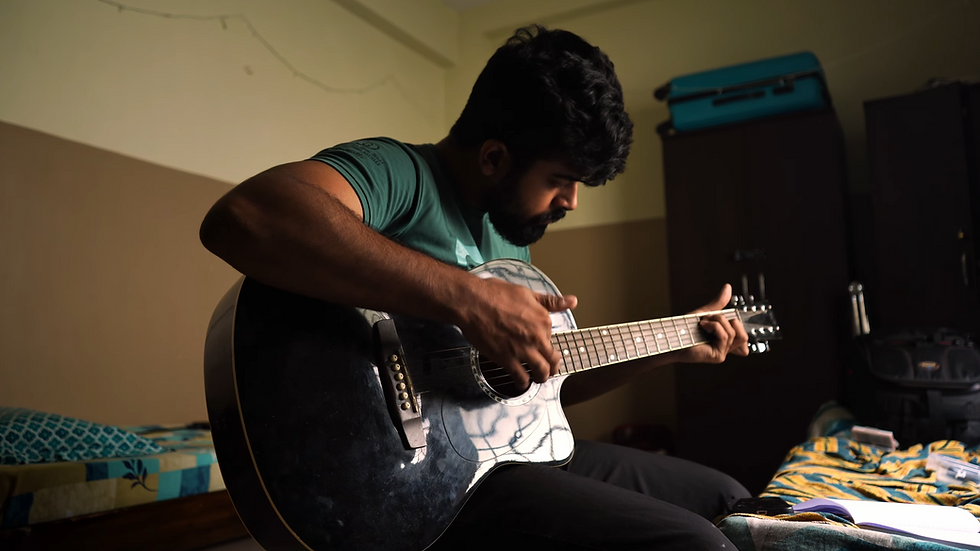The Complex World of Today’s Relationships: Judgment and Guilt
- Tokyo Cine Mag

- May 11
- 4 min read
Review of the Short Film 5 Past 12

The opening of a film often plays a crucial role in establishing a connection between the audience and the work. It’s the beginning that signals whether we can continue watching, whether the film will invite us into its world, or whether no bond will form. The opening lays the groundwork for understanding the film’s universe and approaching its essence. Thus, a film’s opening is always pivotal. Many viewers have abandoned films due to a poor beginning. The short film 5 Past 12 introduces its characters right from the outset, starting with its opening credits. Through parallel editing between scenes of dancing in a club and a formal meeting, the filmmaker immediately hints at the theme of contradiction and the different roles people play in everyday life. This ironic use of contemporary settings is a clever way to start the film. Director Kevin Van Doorslaer seizes the opportunity of the title sequence to establish the characters and events necessary for the story’s foundation. So, when the first scene after the credits shows people in a hospital, we immediately suspect that such a beginning was likely leading to a catastrophe. What kind of event we’re dealing with isn’t clear at first. Has Ms. Verbeke, whom we saw dancing and drinking in the club at the start, been assaulted?

Besides Ms. Verbeke, another character is introduced during the credits: Officer Drijvers, a woman with a serious and determined demeanor. Her presence and the questions she’s about to ask Verbeke effectively set the story in motion. The writer and director’s intelligence lies in recognizing the value of surprise. Through the dialogue after Verbeke regains consciousness in the hospital, we learn that she killed a woman in a car accident. The film creates a triangle of three women: the accused, the victim, and the police officer.
The film smartly uses dialogue to provide just enough information for us to grasp its world. It neither resolves all questions nor reveals every detail about the characters’ pasts, nor does it drive the narrative solely through dialogue. The dialogue serves to clarify certain aspects of the story while preserving its ambiguity. As a result, Officer Drijvers becomes a mysterious and enigmatic figure. Her inability to finish the sentence, leaving her words hanging as she exits the hospital room, prompts the audience to wonder: What secret is she hiding? Has she lost a child to similar circumstances? Was she herself involved in a past accident that this situation now painfully recalls? The questions multiply. Is the child seen in the hallway the same woman killed in the accident by Verbeke? If so, why does this child —presumably the spirit or ghost of the deceased— have tearful eyes? One might interpret that the child had a sister who died in the crash, or that Officer Drijvers is seeing her own childhood self in the hallway. This could explain why she can’t complete her sentence. These ambiguities arise through the interplay of dialogue, silence, and minimal information, with the filmmaker skillfully leaving room for various interpretations.
Here, we must return to the film’s credits, to its meticulously crafted opening, which, unlike many modern credits, is designed to address some of the film’s ambiguities. In those initial scenes, in the parallel editing between the club and the group meeting, a closer look reveals that Officer Drijvers is holding a book titled Anonieme Alcoholisten (Anonymous Alcoholics). Upon rewatching the film, we realize that the meeting is actually a session for recovering or recovered alcoholics. Thus, the initial contrast between the two worlds shown in the film is meant to align concurrently. We see two distinct worlds, but with careful attention, we understand they are interconnected. Those attending the Anonymous Alcoholics meeting today were once among the club-goers. By the film’s end, we understand why Officer Drijvers leaves her sentence unfinished: she, too, once struggled with the same issue Verbeke faces now, and their roles could easily have been reversed.

The film’s approach to alcoholism is indirect, which amplifies its impact. It succeeds in critiquing individuals’ actions without overly blaming or condemning them. The film is concerned with people’s behaviors and decisions, not their inherent selves. The filmmaker’s gaze is as compassionate toward Verbeke as it is toward the grieving, angry father in the hallway or the police officer. In the situation that unfolds, the accused and the officer are judged equally, and the filmmaker’s great artistry lies in avoiding black-and-white perspectives and instead exploring causes.
With thoughtful cinematography, editing precisely tailored to the film’s rhythm and tone, and effective use of its actors, the film presents a holistic picture. It shows how any of us could have been in the accused’s place on that hospital bed and emphasizes the need to judge complex situations with an open mind and broad perspective. Social issues, it suggests, should be addressed through empathy rather than violence or punishment. In its brief runtime, 5 Past 12 manages to articulate its themes visually, with a direct yet cinematic tone, introducing its characters and presenting a fair and comprehensive depiction of the situation. The open-ended conclusion underscores what matters most to the filmmaker: highlighting the complexities of modern life.


















Comments